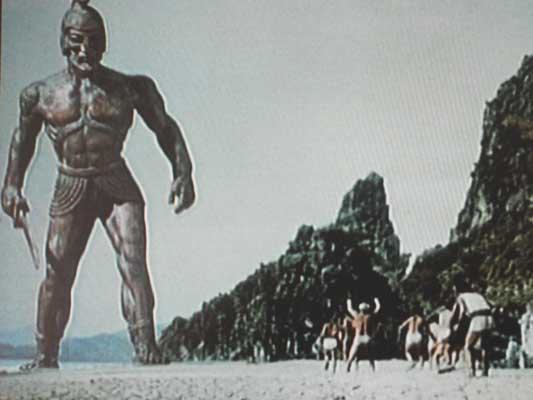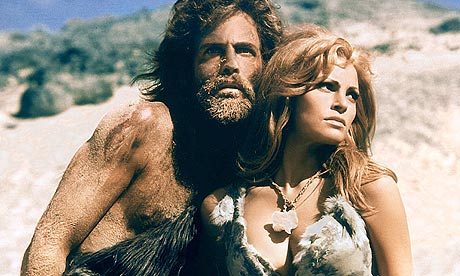 In late February 1912, Edgar Rice Burroughs’s “Under the Moons of Mars” appeared in the pages of an obscure American pulp fiction magazine (All-Story) under the unassuming pen-name of ‘Norman Bean’.
In late February 1912, Edgar Rice Burroughs’s “Under the Moons of Mars” appeared in the pages of an obscure American pulp fiction magazine (All-Story) under the unassuming pen-name of ‘Norman Bean’. In early March 2012, exactly 100 years later, a $250m IMAX 3D film was released across the globe, entitled John Carter. The film is directed by Andrew Stanton (the creator of Wall.E), and written by Michael Chabon, the genius-with-a-Pulitzer-to-prove-it behind such epochal novels as The Amazing Adventures of Kavalier & Clay. Despite the presence of these names, and of respectable™ acting talent (albeit CGI-obscured) including Willem Defoe, Dominic West and Samantha Morton, the film seems to have been an all-round commercial disaster. Belying its quarter-of-a-billion budget, John Carter opened second in the US box office, making just $30m in its opening weekend, and notching up the rather fragile score of 53/100 on the oracular metacritic.com.
The century that separates ‘Norman Bean’s triumph from Stanton and Chabon’s apparent disaster was, of course, a turbulent one. Just two years after “Under the Moons of Mars”, the world experienced global conflict for the first time, only to repeat the experiment two decades later. By the time Burroughs died in 1950, America and the USSR were heading towards nuclear standoff, and a militarily fueled race into the solar system that the author had (scientifically dubiously) imagined for us all. In these decades, Burroughs’s fiction was a constant draw for the new medium of cinema, and if Warner Bros’ anarchic savant Bob Clampett had succeeded in funding his bizarrely rotoscoped 1936 project, it would have beaten Disney’s 1937 Snow White to become the world’s first animated feature film:
In the years following Clampett’s aborted project, and E.R. Burroughs’s death, Jason & the Argonauts’ visionary, Ray Harryhausen, frequently expressed his desire to bring John Carter to the big screen, a project for which no models or sketches survive, but which would, no doubt, have blown a thousand 10-year-old minds:
Once Harryhausen moved on to other pastures, and after Robert Rodriguez gave up on the idea of making John Carter his follow-up to Sin City, the project at last arrived at Disney, the financial home of Clampett’s rival, Snow White, in the hands of Stanton and Chabon (two childhood fans of Burroughs).
In the summer of 2011, when the first teaser trailer for the film was released, it became apparent that ‘Norman Bean’ had found a truly devoted pair to bring his vision to the IMAX:
The ponderous teaser reportedly infuriated the Disney studio, with its deliberate emphasis on Burroughs’s strange framing device; “Under the Moons of Mars” was originally set back in 1866, with ‘John Carter’ as a dislocated symbol of the antebellum South, a Virginian captain who served in the American Civil War. The sandy wastes of Mars, populated by foreign beings and customs, were thus a cracked mirror to the American West, the desert land that eventually separated Burroughs himself (dying in California) from the Illinois of his birth.
The intriguing material in this trailer, recalling the glorious melancholy of Wall.E’s opening half-hour, was not popular with Stanton’s studio. Despite their early concern, however, it is perhaps the later, effects and action-orientated scenes (filling subsequent trailers) which ought to have caused them worry. The extent to which George Lucas had ‘borrowed’ from Burroughs’s books in creating Star Wars (1977) is staggering (either lifting names directly – the Sith – or ‘adapting them’: John Carter’s ‘banths’, giant cows, become his own ‘banthas’, also giant cows; Princess Dejah in a metallic bikini on a flying boat becomes Princess Leia in a metallic bikini on a flying boat…); adapting the book since 1977 presents the unique challenge of adapting an ‘original’ in the shadow of a ubiquitous ‘copy’: as Stanton puts it, the film is perilously close to becoming a 'xerox of a xerox'.
One route open to Stanton and Chabon would, of course, have been that followed by James Cameron in Avatar (2009): to derive material and ideas from Burroughs while bringing him scientifically up-to-date. Cameron’s visually splendid world is also, realistically, toxic to human lungs, for example, and on Pandora any interaction with alien bodies is facilitated only through the 21st-century cyber-technology of the title.
Instead of applying this kind of ‘sci-fi update’ mechanism, however, the filmmakers have chosen a much more unusual, and commercially risky, strategy. Looking back, in particular, to the swarm of 60s–80s genre cinema (the era when both artists were growing up, and falling in love with Burroughs’s work), Stanton and Chabon seemed to have seen, in this heap of VHS ‘trash’, an aesthetic palette with which to capture the paradoxical sense of familiarity/dislocation invoked in the original work. Burroughs’s deliberate decision, in 1912, to place John Carter’s story back in the Reconstruction-era turbulence of America circa 1866–1888 (the years in which the first three books, on which the film is largely based, are set) is an identical temporal jump as that taken by Stanton/Chabon in 2012. While following Burroughs’s specific emphasis on American history, they aesthetically turn the clock forward by a century for their models, looking at our own cultural record of 1966-88…
The twenty-two years (of exclusively genre cinema) to which the filmmaker/writer turn – mimicking in 2012 the retro-period-evocation Burroughs performed in 1912 – thus ranges deliberately from the science fiction/‘cave and sandals’ films of the late 1960s...
One Million Years B.C. (1966)
Mars Needs Women (1967)
Barbarella (1968)
The Valley of Gwangi (1969)
...and ends with the visually-unmistakable fantasy epics (now filling the tape bins at car-boot sales) of the 1980s:
Flash Gordon (1980)
Conan the Barbarian (1982)
Krull (1983)
Dune (1984)
Masters of the Universe (1987)
Refusing to update their material, Chabon (whose retro novel covers enact a similar temporal leap) and Stanton thus choose to create an aesthetic time capsule, a Tarantino-style experiment in genre recreation. Fleeing the shadow of James Cameron, the filmmakers have created an unexpected childhood fantasy. Their experiment, ominously for the money-counters at Disney, resembles another recent wonder (that also fared disastrously with audiences): Indiana Jones and the Kingdom of the Crystal Skull. (In a further instance of retro-detailing, the gung-ho horse & pistols portrait of 1860s America with which Stanton's film begins bears the unmistakable 1981 stamp of Raiders of the Lost Ark.)
Where Steven Spielberg chose, in his 2008 film, to create a haunted image of the 1950s, complete with UFOs and bomb-paranoia, this century-old John Carter emerges as a gigantic VHS-tape hero, burdened with the weight of American history, and transplanted onto an IMAX screen, in 21st century 3D. The resulting film, probably the most risky quarter-of-a-billion Disney have ever spent, is a unique collaboration between two gifted artists: a bizarre reconstruction of a wasteland of kitsch, and an evocation of a 22-year long cultural period as alien to us as the Civil War was to Carter's original creator, the mysterious 'Norman Bean'.











